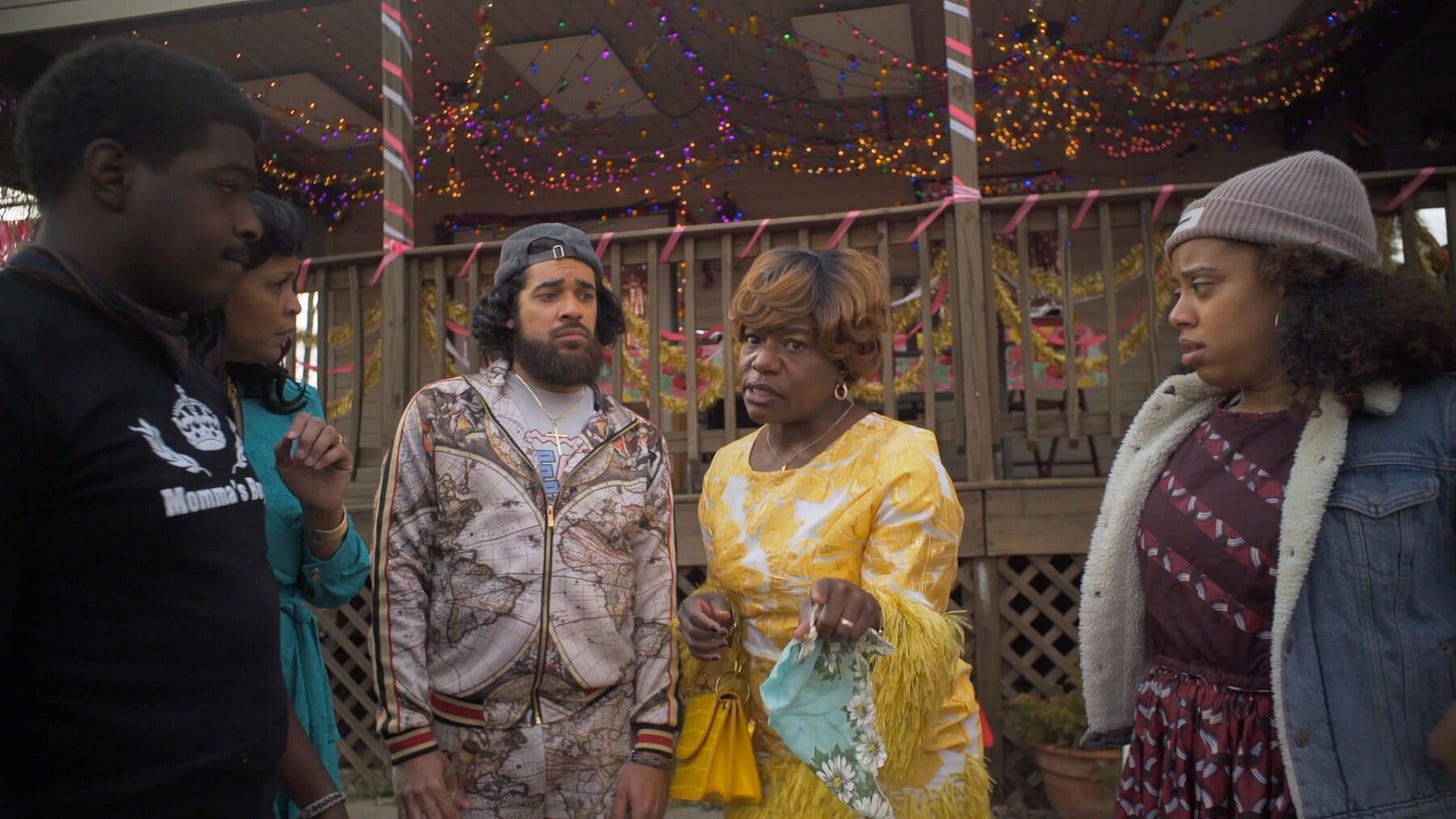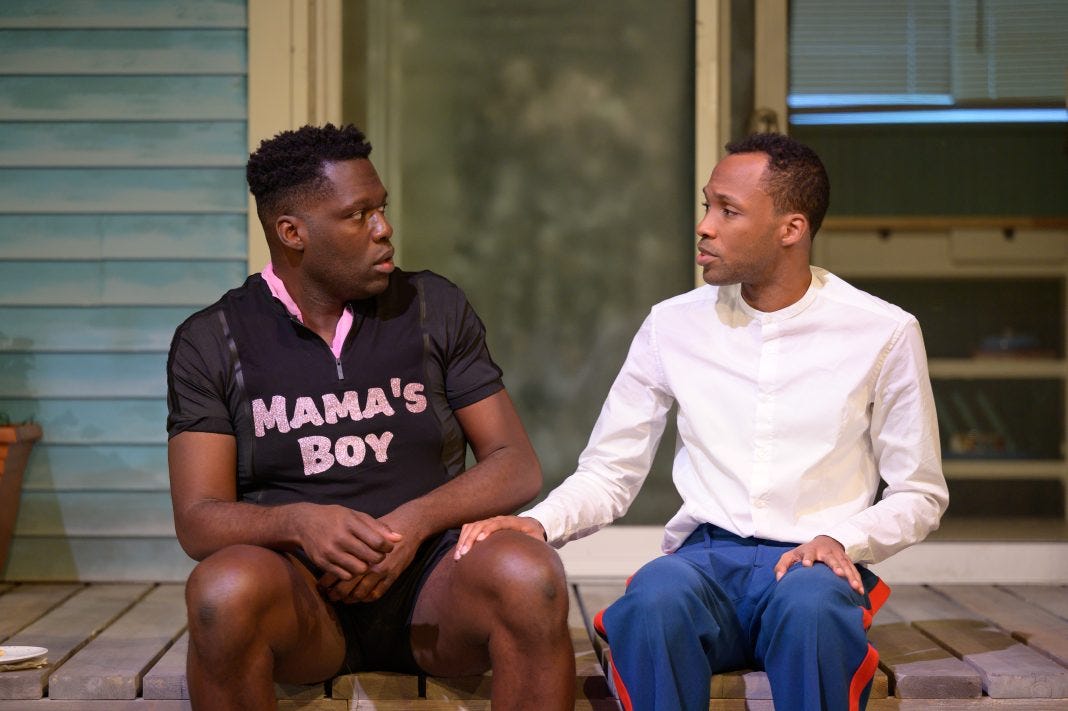A brief note:
I’m going to get deep into it here, which isn’t what I planned when I walked into the theater on Saturday. But this is my first review here and I had no plan. The newsletter format affords a great deal of flexibility that I’ll be taking advantage of. The other thing about newsletters? No editor, for better or worse. So don’t take this as a model for future editions, I’m certainly not.
There’s a handful of mild spoilers ahead, but, y’know, Fat Ham is a riff on Hamlet. If I’m a little curt in places, or something doesn't make sense, blame the cold I’ve been battling since Sunday rather than my disposition.
The Wilma stages James Ijames’s the Pulitzer prize winner with mixed results
The Wilma’s new production of Fat Ham is special in many ways. It’s a Pulitzer winner and Broadway hit. It premiered as a video production by the Wilma in 2021, which made it eligible for Pulitzer nomination, and is now on the Wilma stage for the first time. Where necessary for clarity, I’ll be referring to this production as Fat Ham 2, and the video as Fat Ham 1. This itself is something I’ll discuss, along with the play and the production.
This production is solid, it’s fine, generally well acted, directed, and designed to the standards one would expect a regional theater like the Wilma to have (though the Wilma tends to make more adventurous decisions), and likewise it also doesn’t stand out stylistically, it’s not risky. It is not always successful, nor is the play, but the play is laudable in its ambition and adventurousness. The big way it does stand out is that this is a Black play by a Black playwright, with a Black cast, and a Black director. The audience was less homogeneously white than what I typically see in these houses. This is the full extent of my discussion of race in the play. It’s not a play about race, though race informs all of the things in the play, especially when it comes to generational trauma. But it’s not really a play about trauma either, it’s a play about gender, or at least about how trauma and gender meet. Then there’s the whole Black play-for-white-audience thing, which is a can of worms that is, in the fullest sense, beyond the scope of today’s newsletter. Anyway:
The play takes risks, and the Wilma deserves credit for championing it. Where I don’t like the direction, it’s because it doesn’t take risks to match the tenor of the text, although the straight forward, safe approach makes sense as a way to try to ground this wild play. It has a lot to say about gender. It has structural problems. Despite being Hamlet (or is it?), it’s not a tragedy, nor is it just a comedy, and it’s also not a tragicomedy. It wants to have its cake and eat it too, to be both a screwball comedy and a riff on tragedy. But the play is perhaps hamstrung by a lack of ambition in another way, cramming itself and all its ideas into the easily producible < 2 hour format.
Digital Doubles
When I saw Fat Ham 1, I didn’t think much of it. It was fine, I guess? It’s a play that is perhaps especially ill-suited to the video format, as much of it plays not only with theatrical history (Hamlet) but also with stage conventions, especially direct address. I think video theater is mostly bad, anyway. I find it both difficult to engage with and not very engaging, unless it’s working with the format in a more meaningful way (in which case, is it really even theater?), or is produced at a highly professional level, more of a filmed theatrical production (National Theatre Live, etc.) than video theater, or, as I like to call it: television.
What we saw during the crisis mode of the pandemic was theaters making, essentially, low budget films that are theater in name only because of who made them. Some will argue with me about digital theater or whatever, and to them I would say, “what is your definition of theater?” except this essay isn’t about that, it’s about Fat Ham. What Fat Ham 2 suggests, by its mere existence, is that even the theaters who made these video-plays don’t think of them as theater. Why else would the Wilma bring back a play they produced not three years ago? Surely it is not (only?) a cynical cash grab, a sure-thing hit after Broadway success, but also a recognition that their video production wasn’t really a production of the play. Even theaters don’t think digital theater is really theater. I hope that settles this debate forever and we can all move on.
Ham is an ambitious piece of work, and so I don’t want to fault it for all the problems I see in it. There’s much to like here. Ambition and risks are good. And, importantly, these faults have not been impediments to the play’s success, both popular and critical (Note to theaters: Take risks!!). I do wonder if Fat Ham 1’s video (and the pandemic) did the play a disservice, developing it for film and depriving the play of the traditional rehearsal process for the stage. On the other hand, it won the Pulitzer
Direction and Design
Amina Robinson’s stages the play as a kind of backyard realism, Sara Brown’s set providing a naturalistic backyard, a back porch, a bbq, picnic table and a shed, which fails to prepare the audience for the magical and meta ahead. This might be fine in Hamlet, where the only supernatural element is the ghost, but Fat Ham delivers a few of its punches through meta-theater that knocks down the fourth wall. There’s no visual element that communicates this. At times the staging is flat, pushed downstage by the house taking up so much room toward the back, and much of the comedy leans slapstick, which was more than occasionally too on-the-nose.
Immediately, the show begins with an announcement over the PA by Brenson Thomas, in character as Juicy (Hamlet but also not-Hamlet), delivering the dreaded curtain speech. Welcome, enjoy the show, turn off your cell phones, thank you to our donors, etc. Was this a clever way to introduce the metatheater that is to come? That this happens before the play even begins, before the lights have gone done, makes it hard to read it as such. Maybe some people liked Juicy yelling at them about their phones, cute, right? but I think it’s a terrible way to introduce your protagonist.
The lighting and sound design, by Shon Causer and Larry Fowler respectively, was mostly fine but generally unremarkable (which is how a lot of people like it). Causer deserves credit for lighting the Black cast appropriately. A pair of LED lights at either side of the stage, focused slightly toward the audience, were distracting as they were often on not just when the house was lit, but much of the time when there was playing happening downstage. At one point the stage was dark, the action was happening stage left, but a light stayed on on the center-right porch light. And reader, yes, I kept looking back at it. The lights change up the world when they need to, and the sound effectively underscores when things are getting weird. There’s an important, sustained music cue that is too loud, and the cue going into it was sloppy—which perhaps can be forgiven, given the technical challenge of coordinating with stage action
Plot, Action, Acting
Now, reader, there are plenty of other readers who will rehearse the plot of the play to you. So much has been written about Fat Ham that I’m going to avoid doing that. Since much of it mirrors Hamlet you probably also don’t need to hear it.
Juicy (Hamlet) is a gay (closeted, but the closet door is glass) college student whose dad was murdered in prison, and he’s upset about it (Prince of Denmark he is not). He’s wearing black and says he’s mourning and pissed, but we’re never given a good reason for why he’s so upset about it until Pap’s ghost (Lindsay Smiling, who is consistently excellent. He also plays Rev, and is one of three actors reprising their roles from Ham 1) shows up to haunt him. Is Juicy just emo? He’s wearing black and upset because that’s Hamlet, and I guess he’s trying to annoy his mom for immediately marrying his uncle, but I don’t quite see the big deal. It’s creepy, maybe, but Pap’s been out of the picture a long time, and he also sucked? Your mileage may vary.
I didn’t love Thomas as Juicy (I think I liked him more in Ijames’ Abandon at Theatre [sic] Exile, where he’s the ghost). It’s also possible I just don’t like Juicy. He does a good job, he successfully carries the play, a huge challenge, especially with no intermission. But I never once believed he was in his early 20’s. The play never tells us how old he and his peers are, but it gives us hints: they talk about their future and what they want to do with their lives. Tio (Anthony Martinez-Briggs, also returning) is old enough to buy alcohol. We have fewer clues for Opal (Jessica Johnson) who is under some control of her mother (Zuhairah as Rabby, in the Polonius role), but her older brother Larry (Brandon Pierce, reprising the role) is a Marine corporal.
Inconsistencies
Juicy is a student studying HR (he “likes people,” a recurring joke against his emo disposition, suggesting he’s like this all the time and not just mourning) at the University of Phoenix. This is played for laughs, especially when it’s, rather accurately, called a scam. Which leads me to another question: when does this play take place? The online college has more-or-less collapsed, and was already in a process of collapse as early as 2015. We get a reference to a song from late 2020. Larry has killed someone, and been deployed, but not exactly “at war” (the US’s war in Afghanistan didn’t end until 2021). Tio streams porn on his phone. Rev (Claudius) has promised to take Tedra (Gertrude, played by Donnie Hammond) on a cruise to the holy land (...). So when are we? How old are these people? If Juicy is such a thoughtful guy who likes to reference Shakespeare, how did he get suckered into the University of Phoenix? Ok, it’s a comedy, but what gives? It is a scam, a huge one that ripped off a lot of people!
I hope that complaint is an adequate segue to this bigger one, tied into Robinson’s staging but also part of the play itself: the rules of the play are inconsistent. By rules I mean the internal logic of the piece, of the world of the play; the things the characters and actors have to live and play by. Juicy makes an aside to the audience. He makes another aside, and another character notices him doing it. During another aside, another character seems aware of it, but unable to hear it. Juicy has a few lines that riff directly on, or cite, quote, etc, Hamlet, but he also breaks into full Hamlet soliloquies. Thomas handles these well, but they’re jarring. This is where the play starts to stop working for me, in what I’ll call the second act.
I call it the second act because there is a very natural place for an intermission, following a karaoke scene roughly in the middle of the play that culminates in Juicy singing Radiohead’s Creep (Is using someone else’s entire song as a key dramatic element in your play cheating? What’s the music budget for this show?). It’s a showstopper. The lights get low and the other cast members on stage back him up, dancing. It’s a little too loud. There’s a big round of applause. Lights out! No, not really. They come back up and the play continues. I am a partisan for intermissions. They give actors a break. Audiences can stretch and use the bathroom, have a smoke, reset their focus, buy booze. We can leave if it’s bad. And dramatically, they serve as an oh-so-magical chapter break, even more so than a normal scene break, to let the consequences of the first act play out, to stew and fester, before we get back to the action.

An Incomplete Journey
Fat Ham needs something like that, the way it gets from Creep karaoke, to its climax, and then to the literal party of love and acceptance of a finale doesn’t fully add up. Juicy maybe learns to reluctantly forgive his uncle, but we never see that because Rev dies in a hilarious way, and I don’t think he actually grows (he wrongs Larry in a very serious way and doesn’t apologize), but rather the obstacles he was facing (the toxic men in his life) remove themselves (Pap and Rev die), or change (Larry). Opal walks on knowing who exactly she is, but is afraid to express it: she gains the confidence to come out and take off the dress imposed on her. Larry is the only character who is truly transformed, learning to accept himself and come out (literally and spectacularly). He’s the heart of the play. Oh! Larry! Cast off that terrible shell! The mothers accept their kids. But all the characters also realize that they’re in a play, a tragedy, in Hamlet! (Again—the rules—are they in Hamlet, or are they living their lives? They’re in a play, and that play is Hamlet, or maybe not and yet the characters in the play can also reference Shakespeare and the fictive work that they are currently in? How does that work?) And that they don’t have to play the play within their given roles—they don’t all have to die. No pile of bodies in this Ham.
There’s a speech that I think is meant to bridge this second half gap; to get the characters, and us along with them, to this radical point. It’s a long monologue from Tio (stoner Horatio) about playing a virtual reality video game when, much to his surprise, he gets fellatio from a gingerbread man and learns to accept that he likes getting head from a gingerbread man and that it’s going to be a big part of his life going forward. It’s an absurd speech, it’s long, not especially funny, mostly relying on how absurd it is for laughs. It was static, and is too absurd, confusing, and out there to do the heavy lifting required to advance the dramatic action. I think it’s also a bit of telling instead of showing, which is a rule I believe in breaking, but doesn’t work to convey something so big as the forgiveness, growth, and healing that is supposedly happening. An intermission might not have helped that, but maybe it would give the play more room to maneuver.
Gender Trouble
If Fat Ham is a play about generational trauma, healing, and moving on, Juicy does face some of it and grow, doing a little of that tough internal work. But Pap is dead, and Rev is responsible for his own death. That’s generational trauma cutting itself off, not being healed. After his death as Rev (spoiler alert), Lindsay Smiling gets back up and joins the finale-party, suggesting only the deus ex machina can heal that much baggage.
But it’s not really a play about intergenerational trauma, it’s a play about gender. Pap and Rev are both figure soaked in toxic masculinity, and they both die. Larry is penned in by masculinity and heteronormativity, literally constrained in a dress uniform which he chose to put on. When he comes out, he’s shed that skin and is in something showy and feminine. Opal is annoyed that her mother doesn’t want her to present as butch. Juicy is soft and femme. The play makes much of this softness, presenting it in stark contrast to the hardness that Pap and Rev have, and that Larry has molded himself into. With the death of toxic masculinity, the stage is filled with femmes, except for Opal. The only masc on stage is a woman. So the play doesn’t just reject toxic masculinity, it rejects all masculinity. It embraces femininity.
This to me is where the play really disappoints by not offering a positive, healthy, healed vision of masculinity even as it fills the stage with so much gender. What if Rev could really heal? Is there no hope for him? I think the play does a disservice by not really wrestling with intergenerational healing—the mothers can accept their kids, why not the men? what if Rev let Juicy save him? Where does that play go? What transformation is required for that to happen? The end of the play promises that the cycle can be broken, that no one more need die. So why does Rev have to?
None of us are going to be healed by a virtual gingerbread man sucking our dicks, and none of us are going to do it alone. Maybe I’m asking too much of a comedy, but Fat Ham aims to be more than just a comedy. This is a bold play that's worth seeing and thinking about. The Wilma’s new production doesn’t always serve it best, but it does serve.
A Good Meme
The left escalator leads to Philly (h/t to Aaron Van Scyoc)









